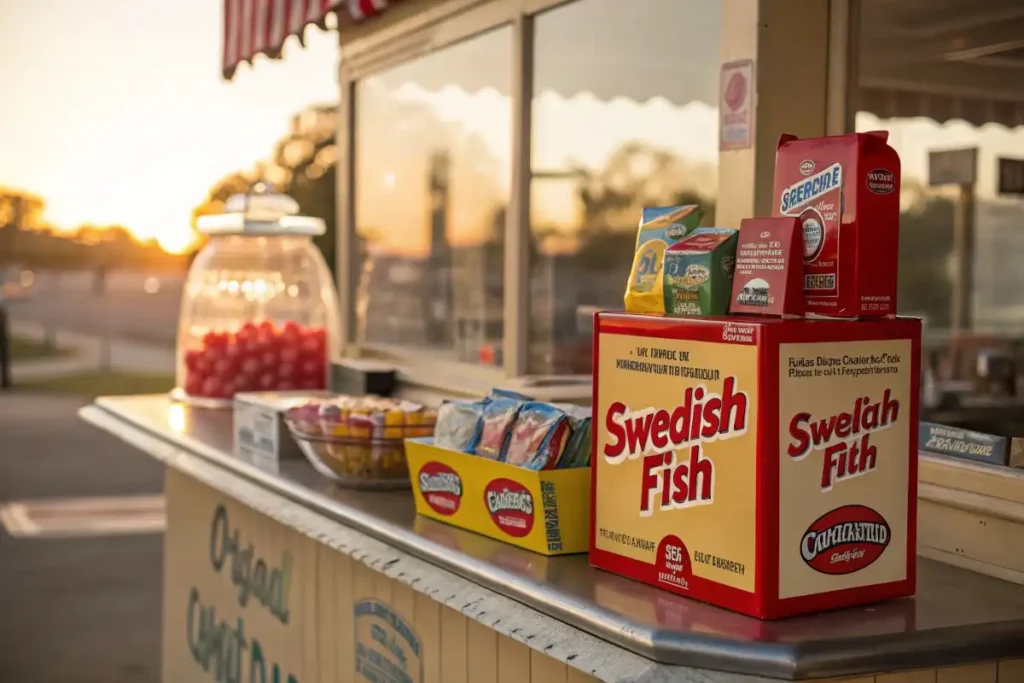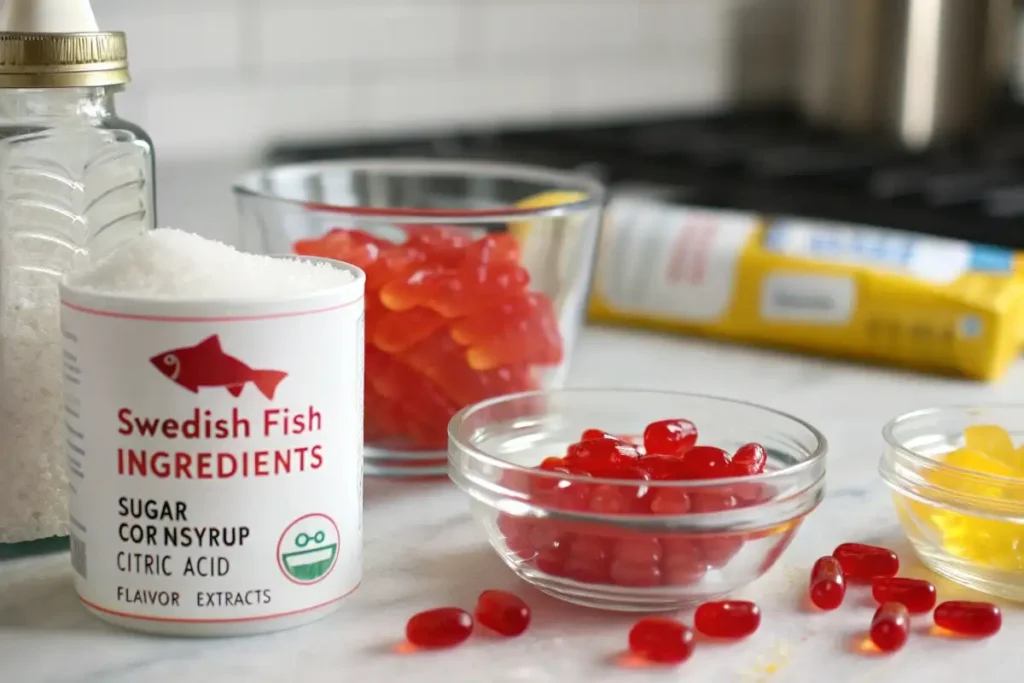Few candies have captured hearts across generations quite like Swedish Fish. With their iconic red color, chewy texture, and mysteriously delicious flavor, these gummy candies have been a staple in the candy industry for decades. But where did they come from? How did they gain worldwide popularity? And why are they shaped like fish?
In this article, we’ll take a deep dive into the history, ingredients, and cultural significance of Swedish Fish. From their humble beginnings in Sweden to their rise as a beloved candy in the U.S., we’ll explore what makes them so unique. We’ll also look at their production process, nutritional facts, and even their influence in pop culture. Stick around for some fun facts, FAQs, and insights into the future of this classic treat!
Introduction to Swedish Fish
The Origin of Swedish Fish
Ever wondered why Swedish Fish are shaped like fish? It all traces back to Sweden in the late 1950s when the candy company Malaco introduced them to the market. Since Sweden has a long tradition of fishing, the company thought a fish-shaped candy would appeal to locals. Little did they know, it would soon become an international sensation!
Originally, these chewy treats were only available in Sweden. But as their popularity grew, they caught the attention of American candy distributors, leading to their introduction to the U.S. market.
Why This Candy Became a U.S. Favorite
Fast forward to today, and Swedish Fish are a household name in America. Unlike traditional gummy candies, which use gelatin, these are made with a unique starch-based formula. This makes them not only deliciously chewy but also gelatin-free, making them suitable for vegetarians.
The U.S. version of Swedish Fish has remained largely unchanged, with the classic red color and its distinct berry-like flavor. Over the years, new flavors and limited editions have been introduced, but the original remains the favorite.
From movie theaters to convenience stores, these chewy fish-shaped candies have swum their way into people’s hearts, and their popularity shows no signs of slowing down.
History and Evolution of Swedish Fish

Creation by Malaco in 1957
The story of Swedish Fish began in 1957 when the Swedish candy company Malaco created these chewy, fish-shaped treats. At the time, Sweden had a strong fishing culture, so designing a candy shaped like a fish made perfect sense. Unlike other gummies, Swedish Fish were made with a unique recipe that didn’t include gelatin. This gave them a distinct chewy texture while making them a popular choice among vegetarians.
These candies quickly became a hit in Sweden, but their journey was far from over. Soon, they would cross the Atlantic and gain a new audience in the United States.
Introduction to the U.S. Market
In the 1960s, This Candy made their way to America, thanks to a partnership between Malaco and the U.S. confectionery company Cadbury Adams. American candy lovers embraced them right away. Their soft, chewy texture and fruity, berry-like taste were different from traditional gummy candies.
What really made Swedish Fish stand out was their ability to hold their shape and consistency over time. Unlike gelatin-based gummies, they didn’t melt easily or become sticky, making them a great option for movie theaters, road trips, and snack drawers.
Over the years, their popularity continued to grow, cementing their status as a classic American candy.
Evolution of Flavors and Colors
While the original This Candy were red with a signature fruity flavor, new varieties have emerged over time. Today, you can find them in a mix of colors and flavors, including:
- Green – Lime
- Yellow – Lemon
- Orange – Orange
- Blue – Raspberry
Despite these additions, the classic red Swedish Fish remains the most loved. Limited-edition flavors have also popped up over the years, including tropical and sour versions, keeping the brand fresh and exciting.
Though they’ve evolved in many ways, the core identity of This Candy remains unchanged—a chewy, fish-shaped candy loved by generations.
Ingredients and Production Process

Key Ingredients in Swedish Fish
Ever wondered what makes Swedish Fish so uniquely chewy? Unlike other gummy candies, they don’t contain gelatin. Instead, they are made from a mix of:
- Sugar – Provides sweetness
- Invert sugar – Helps retain moisture
- Corn syrup – Adds texture and prevents crystallization
- Modified corn starch – Gives them their signature chewiness
- Citric acid – Enhances the fruity flavor
- Artificial flavors and colors – Create their distinct taste and bright red color
Because they don’t contain gelatin, Swedish Fish are vegetarian-friendly, making them a great alternative to traditional gummy candies.
Manufacturing Process
The process of making This Candy is surprisingly precise. It starts with mixing the ingredients into a thick syrup, which is then heated and poured into fish-shaped molds. After cooling, they are coated with a light wax to prevent them from sticking together.
Each batch undergoes strict quality control to ensure every candy has the same chewy texture and fruity flavor that fans love. This careful process has kept Swedish Fish consistent for decades.
Nutritional Information
While This Candysh are a fun treat, they are high in sugar and should be enjoyed in moderation. A standard serving (about 19 pieces) contains:
- 150 calories
- 0 grams of fat
- 38 grams of carbohydrates
- 34 grams of sugar
Since they are fat-free and don’t contain common allergens like dairy or nuts, they are a safe candy choice for many people. However, like most sweets, they should be eaten in moderation as part of a balanced diet.
From their simple ingredients to their chewy texture, Swedish Fish have remained a fan favorite for decades. And with their timeless appeal, they’re likely to be around for many more years to come!
Cultural Impact and Partnerships

Swedish Fish in Pop Culture
Over the years, Swedish Fish have swum their way into various facets of pop culture. Their unique shape and chewy texture make them stand out among candies. They’ve been featured in movies, TV shows, and even music videos, often symbolizing a fun and nostalgic treat. For instance, in the 2016 YouTube mini-series “Treadin’ Water,” a giant Swedish Fish shares an apartment with friends, highlighting the candy’s playful image.
Moreover, the brand has embraced digital trends to connect with younger audiences. In 2024, Swedish Fish launched the “Sel-Fish” holiday campaign, featuring a humorous take on Santa Claus indulging in the candy. This campaign resonated with Gen Z’s quirky humor and went viral across social media platforms.
Collaborations with Other Brands
This chewy candy has a history of successful collaborations, expanding its reach beyond the candy aisle. In 2009, the brand partnered with Rita’s Italian Ice to introduce a Swedish Fish-flavored Italian ice, delighting fans with a frozen twist on the classic candy.
In 2016, a unique collaboration with Nabisco led to the creation of Swedish Fish Oreos, combining the beloved flavors of both brands into a limited-edition cookie.
These partnerships not only showcase the versatility of Swedish Fish but also highlight its enduring popularity and ability to innovate within the confectionery market.
Limited Edition Flavors and Products
To keep the brand fresh and exciting, This chewy candy has introduced various limited-edition flavors and products over the years. While the original red fish remain a favorite, new flavors like tropical and sour versions have been launched to cater to diverse taste preferences.
Additionally, the brand has experimented with different product formats, such as mini versions and larger “giant” fish, appealing to both long-time fans and new consumers. These innovations ensure that Swedish Fish continues to be a relevant and cherished treat across generations.
Swedish Fish Around the World
Variations in Different Countries
While Swedish Fish originated in Sweden, their global journey has led to interesting variations. In Sweden, these candies are known as “pastellfiskar,” or “pastel fish,” and are part of a popular mixed candy bag called “Gott & Blandat.” The Swedish version differs slightly in ingredients and flavors, often featuring a mix of colors and tastes, including a special black salted licorice flavor known as “salmiak.”
In North America, the classic red Swedish Fish with its unique fruity flavor remains the most popular. However, assortments featuring multiple colors and flavors have also been introduced to cater to diverse palates.
Availability and Distribution
Today, This chewy candy are enjoyed in many parts of the world. In North America, they are widely available in supermarkets, convenience stores, and movie theaters. The brand has also expanded its presence through online retailers, making it easy for fans to purchase their favorite chewy candies.
In Europe, particularly in Nordic countries, Swedish Fish are commonly found in pick-and-mix candy sections, allowing consumers to choose their preferred flavors and quantities. This distribution strategy aligns with the local confectionery culture, where variety and personalization are highly valued.
Consumer Preferences Globally
Consumer tastes for Swedish Fish vary across regions. In Sweden and other Nordic countries, the black salted licorice flavor is a favorite, reflecting local flavor preferences. In contrast, consumers in North America tend to prefer the original red flavor, with its sweet and fruity profile.
Despite these regional differences, the universal appeal of Swedish Fish lies in their distinctive chewy texture and fun, fish-shaped design. This combination continues to delight candy lovers around the globe, making Swedish Fish a truly international confectionery icon.
Frequently Asked Questions
This chewy candy have a unique, fruity flavor that is often described as a mix of berry and cherry with a hint of lingonberry. While the exact taste is a mystery, the classic red Swedish Fish has a distinct, slightly tangy sweetness that makes it stand out from other gummy candies.
This chewy candy are made with sugar, corn syrup, modified corn starch, citric acid, and artificial flavors. Unlike many gummy candies, they do not contain gelatin, making them a great option for vegetarians. Their chewy texture comes from modified corn starch, which helps them maintain their consistency over time.
Many athletes eat Swedish Fish as a quick source of energy during workouts or competitions. Since they are high in fast-digesting carbohydrates (sugar) and contain no fat, they provide an immediate energy boost without causing digestive discomfort. Some runners and endurance athletes even use them as a tasty alternative to energy gels.
While This Candy are fat-free and gluten-free, they are still a high-sugar candy. A single serving contains around 34 grams of sugar, which can lead to blood sugar spikes if consumed in large amounts. While they’re fine in moderation, they shouldn’t be considered a healthy snack due to their high sugar content and lack of essential nutrients.
Conclusion
The Enduring Appeal of Swedish Fish
For over six decades, This chewy candy have remained a favorite candy worldwide. Their gelatin-free, chewy texture and signature fruity flavor make them stand out from other gummy treats. Whether enjoyed at the movies, on road trips, or as an everyday snack, their popularity shows no signs of slowing down.
Future Prospects for the Candy
As Swedish Fish continue to evolve, new flavors, limited editions, and collaborations will keep them exciting for candy lovers. No matter how the brand changes, one thing is certain—these little red fish will always be a timeless and beloved treat!
Why Swedish Fish Will Always Be a Classic
For decades, This chewy candyh have held a special place in candy lovers’ hearts. They aren’t just another gummy treat—they’re a nostalgic icon, a candy that sparks childhood memories and brings people together. Whether you first tried them at the movies, found them in your Halloween stash, or grabbed a handful from a friend’s snack drawer, there’s something undeniably timeless about their unique chewy texture and signature fruity flavor.
But what makes Swedish Fish truly special? It’s their ability to stay relevant while remaining true to their roots. New flavors and collaborations come and go, yet the original red fish remains as popular as ever. That’s the mark of a true classic—one that doesn’t just ride trends but creates them.
As candy aisles change and new snacks emerge, one thing is certain: This chewy candy aren’t going anywhere. They’ve been around for over 60 years, and they’ll keep swimming through generations to come. So next time you grab a bag, take a moment to appreciate the sweet, chewy magic of one of the world’s most beloved candies.


1 thought on “The Sweet Journey of Swedish Fish: From Scandinavian Treat to Global Candy Icon”